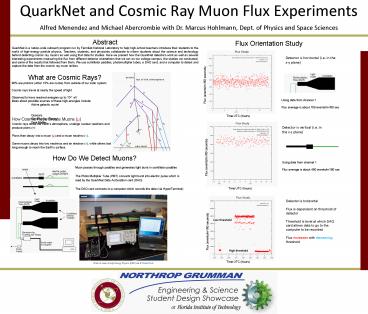QuarkNet and Cosmic Ray Muon Flux Experiments - PowerPoint PPT Presentation
1 / 1
Title:
QuarkNet and Cosmic Ray Muon Flux Experiments
Description:
QuarkNet and Cosmic Ray Muon Flux Experiments. Alfred Menendez and Michael ... Gamma Ray Bursts. Dark Matter. How Cosmic Rays Create Muons ( ) ... – PowerPoint PPT presentation
Number of Views:22
Avg rating:3.0/5.0
Title: QuarkNet and Cosmic Ray Muon Flux Experiments
1
QuarkNet and Cosmic Ray Muon Flux Experiments
Alfred Menendez and Michael Abercrombie with Dr.
Marcus Hohlmann, Dept. of Physics and Space
Sciences
Abstract QuarkNet is a nation-wide outreach
program run by Fermilab National Laboratory to
help high-school teachers introduce their
students to the world of high-energy particle
physics. Teachers, students, and physicists
collaborate to inform students about the science
and technology behind detecting cosmic ray muons
as well using that data for studies. Here we
present how the QuarkNet detectors work as well
as several interesting experiments measuring the
flux from different detector orientations that we
ran on our college campus, the studies we
conducted, and some of the results that followed
from them. We use scintillator paddles,
photomultiplier tubes, a DAQ card, and a computer
to detect and capture the data from the cosmic
ray muon strikes.
Flux Orientation Study
What are Cosmic Rays? 90 are protons (other 10
are nuclei) from outside of our solar
system Cosmic rays travel at nearly the speed of
light Observed to have reached energies up to
1021 eV Ideas about possible sources of these
high-energies include Active galactic
nuclei Quasars Gamma Ray Bursts Dark Matter
How Cosmic Rays Create Muons (µ) Cosmic rays
strike the Earths atmosphere, undergo nuclear
reactions and produce pions (p) Pions then decay
into a muon (µ) and a muon neutrino (v). Some
muons decay into two neutrinos and an electron
(e), while others last long enough to reach the
Earths surface.
Detector is vertical (i.e. in the x-z plane)
How Do We Detect Muons?
- Using data from channel 1
- Flux average is about 450 events/m2/60 sec
- Muon passes through paddles and generates light
burst in scintillator paddles - The Photo Multiplier Tube (PMT) converts light
burst into electric pulse which is - read by the QuarkNet Data AcQuisition card (DAQ)
- The DAQ card connects to a computer which records
the data (via HyperTerminal)
- Detector is horizontal
- Flux is dependent on threshold of detector
- Threshold is level at which DAQ card allows data
to go to the computer to be recorded - Flux increases with decreasing threshold
Low threshold
Flux (events/m2/60 seconds)
High threshold
Time UTC (hours)
Photo of setup in High Energy Physics (HEP) lab
at Florida Tech































